Ijraset Journal For Research in Applied Science and Engineering Technology
- Home / Ijraset
- On This Page
- Abstract
- Introduction
- Conclusion
- References
- Copyright
Classification of Skin Disease Images using EfficientNet Transfer Learning Technique
Authors: Pathri Mahanthesh, Prajwal G M, Narravula Raaja Chaithanya Vedh, N Rahul, Reddy Santosh Kumar
DOI Link: https://doi.org/10.22214/ijraset.2025.66205
Certificate: View Certificate
Abstract
The classification of skin disease images is a vital application of deep learning, particularly through the utilization of transfer learning techniques with models like EfficientNet. Transfer learning involves leveraging knowledge gained from a pre-trained model on a large dataset and adapting it to a specific task, which is particularly advantageous when dealing with limited labeled data. EfficientNet, known for its effectiveness in balancing model size and performance, serves as a powerful feature ex- tractor. The initial layers capture general features from images, and by fine-tuning the later layers, the model can be tailored to the nuances of skin disease classification. This adaptation allows for efficient learning of relevant patterns in dermatological images. To enhance model generalization, data augmentation techniques are applied during training. This involves introducing variations in the training data, such as rotations and flips, to expose the model to a diverse range of scenarios. Additionally, incorporating techniques to handle class imbalances within the dataset is crucial for unbiased learning. Validation during training is vital to prevent overfitting, ensuring that the model generalizes well to unseen data. Evaluation metrics like precision, recall, and F1 score provide a comprehensive understanding of the model’s performance, especially when dealing with imbalanced datasets. In summary, the classification of skin disease images using transfer learning with EfficientNet involves adapting a pre-trained model to the specific task of dermatological classification.
Introduction
I. INTRODUCTION
Skin disease is a prevalent and potentially life-threatening disease that requires early detection and accurate classification for effective treatment. This project focuses on the development of a skin disease detection system using Convolutional Neural Networks (CNNs) to classify different types of skin dis- ease. The dataset used in this project consists of a diverse collection of skin disease images that have been meticulously curated and annotated to provide ground truth information for training and evaluation purposes. This project report focuses on skin disease image classification, employing efficient transfer learning techniques with the EfficientNet architecture. The study explores the application of pre-trained EfficientNet models for enhanced feature extraction and classification accuracy. The overview delves into the rationale behind choosing EfficientNet, detailing the architecture’s efficiency and scalability. The report discusses the dataset used for training and evaluation, emphasizing its diversity in capturing various skin conditions. Methodology includes the fine-tuning process and transfer learning strategy applied to adapt EfficientNet to dermatological image classification. Results and performance metrics showcase the effectiveness of the proposed approach, contributing to the advancement of automated skin disease diagnosis.
II. LITERATURE REVIEW
A. Novel Deep Convolutional Neural Network for Diagnosis of Skin Disease
The research presents a novel Deep Convolutional Neural Network (DCNN) model for the diagnosis of skin diseases with the objective of improving accuracy and efficiency in detection. The DCNN processes dermatological images, removing noise and enhancing features for effective classification using the HAM10000 dataset. Compared to conventional methods like KNN and CNN, DCNN demonstrated superior performance, achieving 98.4% accuracy, 96.3% precision, 97.2% recall, and reduced detection time of 10,000 milliseconds. This approach outperforms existing methods in speed and accuracy, making it a significant advancement in the automated diagnosis of dermatological conditions.
B. Enhancing Skin Diseases Classification Through Dual Ensemble Learning and Pre-trained CNNs
The research focuses on enhancing the classification of skin diseases by using a multi-modal and multi-task deep neural network (DNN) classifier combined with transfer learning. The classifier integrates image data and clinical information, leveraging complementary features from both modalities.
The study utilized the ISIC 2018 dataset, consisting of images and corresponding clinical data of seven skin disease categories. The proposed model achieved an accuracy of 97.66% for image classification and 94.40% for clinical data classification, outperforming traditional single-modal and single-task classifiers. This approach demonstrates the effectiveness of integrating diverse data sources for improved diagnostic performance and patient care.
C. Classification of Skin Disease Using Transfer Learning in Convolutional Neural Networks
The research aims to address the automated classification of skin diseases, focusing on seven conditions commonly found in the Philippines: chickenpox, acne, eczema, pityriasis rosea, psoriasis, tinea corporis, and vitiligo. The study uses a dataset of 3,400 images sourced from open-access dermatological repositories, clinical atlases, and manually collected samples. These images were processed and used to train and test various Convolutional Neural Network (CNN) architectures, emphasizing the use of transfer learning to enhance performance. Other models like VGG16 and VGG19 showed significantly lower accuracies (41.4% and 41.42%, respectively), but they demonstrated faster loading times. ResNet50 and DenseNet121 offered moderate performance, with accuracies of 61.4% and 64.3%, respectively, but required more computational resources.
D. Skin Disease Detection Based on Deep Learning
The research focuses on classifying skin diseases using a model-fusion-based CNN framework combining DenseNet201 and ConvNeXt architectures. The study addresses sparse datasets and class imbalances using data augmentation. With a dataset of 2,600 images of skin conditions, the proposed model achieved high accuracy of 92.88% for DenseNet201 and 92.12% for ConvNeXt, outperforming previous methods in recall and macro-average accuracy. This approach demonstrates effective feature representation and reliable skin disease detection.
E. A Skin Disease Classification Model Based on DenseNet and ConvNeXt Fusion
The research focuses on developing a convolutional neural network (CNN) model for skin disease classification based on model fusion. The proposed model integrates DenseNet201 and ConvNeXt architectures with attention modules to enhance feature extraction and employs parallel strategies to combine deep and shallow layer features. Experiments were conducted on a private dataset of 2,600 images dominated by acne-like skin diseases and the HAM10000 public dataset. The model achieved 96.54% accuracy on the private dataset and 95.29% accuracy on HAM10000, outperforming baseline models and state-of-the-art approaches. This study demonstrates the efficacy of model fusion and data augmentation for improving classification performance.
F. Skin Disease Classification Using CNN Algorithms
The research focuses on classifying skin diseases using deep learning techniques with transfer learning. A dataset of approximately 25,000 images covering eight common skin conditions, such as melanoma and basal cell carcinoma, was used. Various CNN models, including VGG16, VGG19, ResNet50, ResNet152, DenseNet, InceptionV3, and MobileNet, were employed. ResNet152 achieved the best performance with accuracy, precision, and recall of approximately 75%. The study highlights the effectiveness of deep learning models, particularly ResNet152, in identifying skin conditions and emphasizes the importance of transfer learning and image pre-processing for improved classification accuracy.
III. PROBLEM DEFINITION
Automated skin disease detection and classification are paramount for timely intervention and effective treatment. However, existing methods encounter challenges in achieving the desired level of accuracy and efficiency. Manual identification of skin disease lesions by dermatologists is time-consuming and subjective. To overcome these limitations, this project aims to develop a skin disease classification system utilizing Convolutional Neural Networks (CNNs).
The primary objective is to train a CNN model capable of accurately classifying skin disease images into distinct types, including actinic keratosis, basal cell carcinoma, dermatofibroma, melanoma, and others. This entails extracting discriminative features from the images and leveraging a diverse and well-annotated dataset. The dataset will encompass a wide range of skin dis- ease images, accommodating variations in skin types, ages, and ethnicities to ensure model generalizability. The proposed system will harness the power of deep learning techniques to optimize the feature extraction process and train the CNN model. Attention will be given to optimizing real-time or near real-time processing, making the system practical for clinical deployment. The developed system aims to assist dermatologists in making accurate and timely diagnoses, reducing diagnostic time and improving patient outcomes.
IV. METHODOLOGY
This section presents a methodology for the classification of skin diseases using a Convolutional Neural Network (CNN) approach. The system begins by utilizing a dataset of skin disease images, which undergoes image preprocessing to enhance the quality and standardize the data for training. The pre-processed images are divided into training and testing datasets, where the training data is used to train the CNN classifier. The trained model is then tested using the test set to evaluate its performance. For further analysis, the classification results are compared with other feature-based models to assess its accuracy and efficiency. This systematic approach ensures precise classification of skin diseases, aiding in early diagnosis and better medical decision-making.
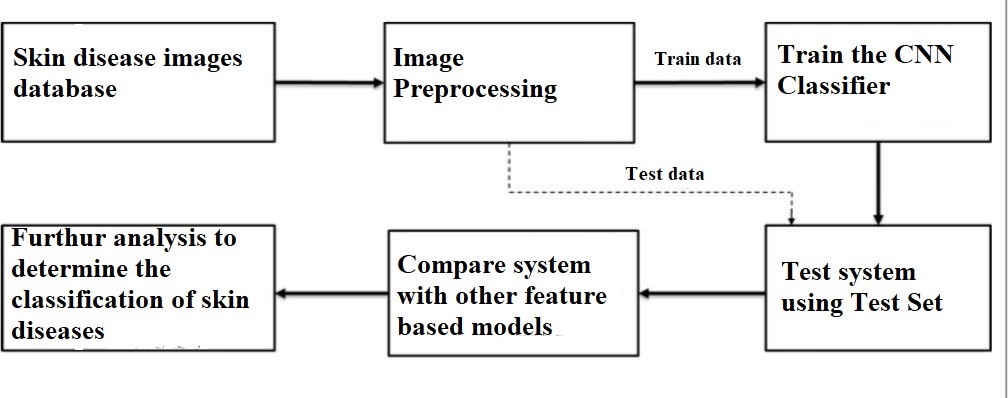 Fig1: system architecture
Fig1: system architecture
A. Skin Image Dataset
It contains different types of skin classes, and each class has sample images. The dataset is inherently noisy, as some images may depict multiple skin diseases, requiring robust preprocessing and model design to handle such complexities.
B. Image preprocessing
The dataset contains different classes of skin images. The dataset is divided into training and testing sets, ensuring that each class of skin images is appropriately represented. This step standardizes the images, preparing them for efficient model training while addressing variations in image quality and features.
C. Training the CNN classifier using pretrained models
The system employs Transfer Learning. This involves utilizing a pre-trained model to extract features from the dataset, which are then used to train a classifier. The extracted features serve as a foundation, allowing the system to leverage the knowledge of a pre-trained model and adapt it to classify specific skin diseases accurately.
D. Validation and Testing
The trained model is first validated using a validation dataset to fine-tune its performance and minimize errors. Finally, the model is rigorously tested on the test dataset to evaluate its accuracy and reliability in classifying skin diseases.
The methodology ensures a structured approach to diagnosing skin diseases by leveraging advanced machine learning techniques. The combination of data preprocessing, Transfer Learning, and thorough validation and testing improves the model’s robustness and ensures reliable performance in real-world applications.
V. RESULTS AND EVALUATION
In this section, the outcomes of the "Classification of Skin Disease Images Using EfficientNet Transfer Learning Technique" project are presented. By leveraging a combination of EfficientNet-based transfer learning and data augmentation techniques, the model achieved robust classification performance across multiple skin disease categories. The training process utilized a diverse dataset of dermatological images, enabling the system to generalize well to unseen cases. The results include evaluation metrics such as accuracy, precision, recall, and F1-score, highlighting the effectiveness of the model in distinguishing between different skin conditions.
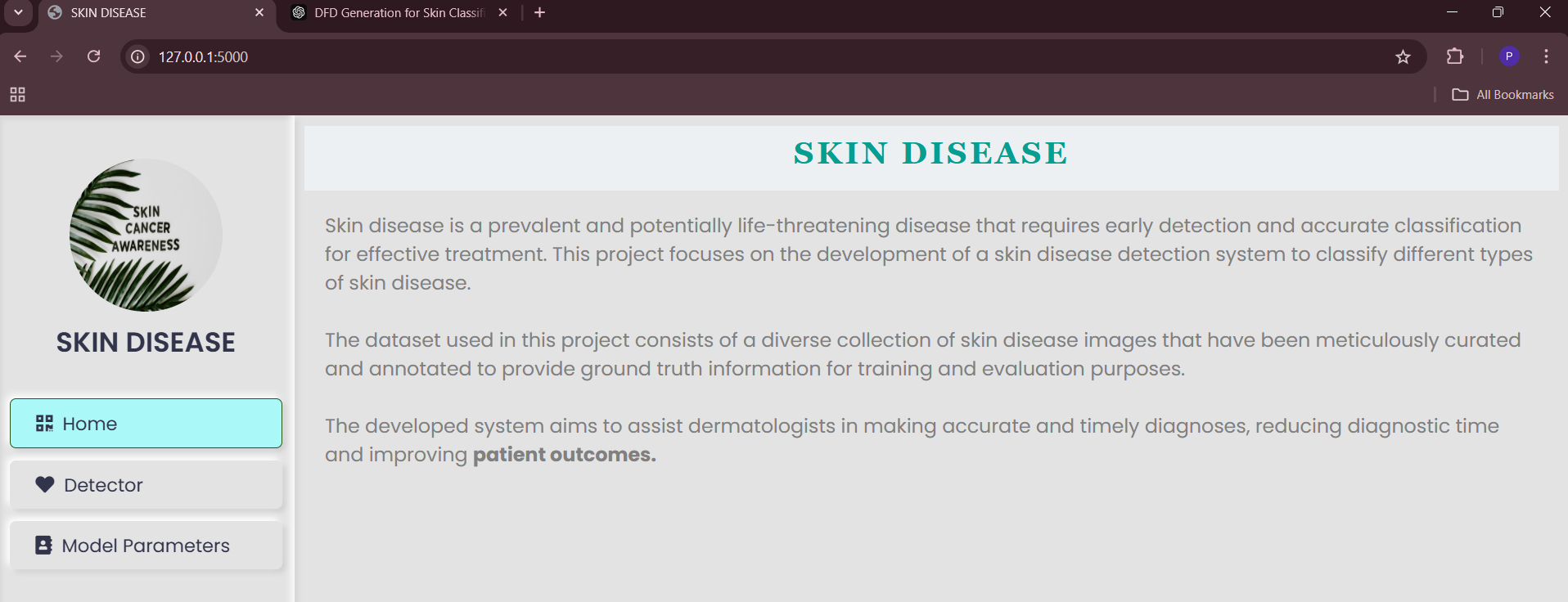 Figure 2 Home Page
Figure 2 Home Page
The homepage of the project serves as an introductory interface for users. The project emphasizes the development of an advanced skin disease detection system that utilizes a meticulously curated and annotated dataset of skin disease images. The user-friendly interface ensures accessibility, with clearly defined sections for navigating the system, detecting skin conditions, and reviewing model parameters, reflecting the project's commitment to clinical efficacy and usability.
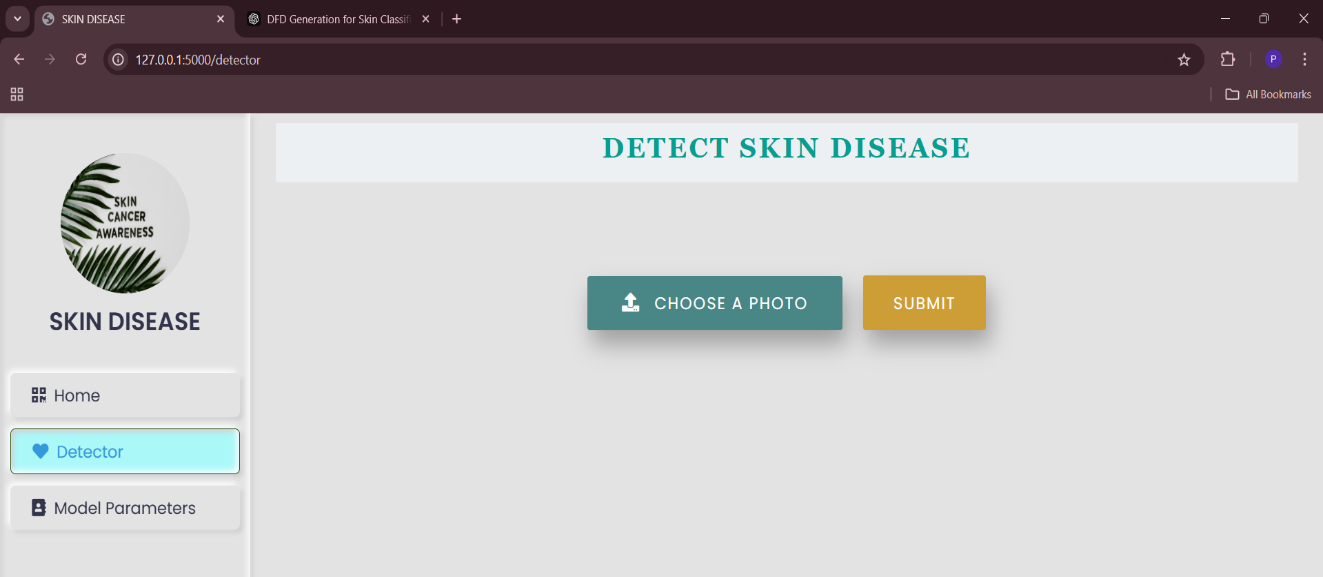 Figure 3 Detector
Figure 3 Detector
The "Detector" section of the project provides an interactive interface for users to upload images of skin conditions for analysis. This module is designed to facilitate the detection and classification of skin diseases using the trained EfficientNet model. Users can select an image by clicking the "Choose a Photo" button and then submit it for processing by clicking the "Submit" button. Upon submission, the system analyses the uploaded image, identifies potential skin conditions, and returns a detailed classification result. This feature streamlines the diagnostic process, offering an intuitive and efficient way for users to obtain insights about skin conditions.
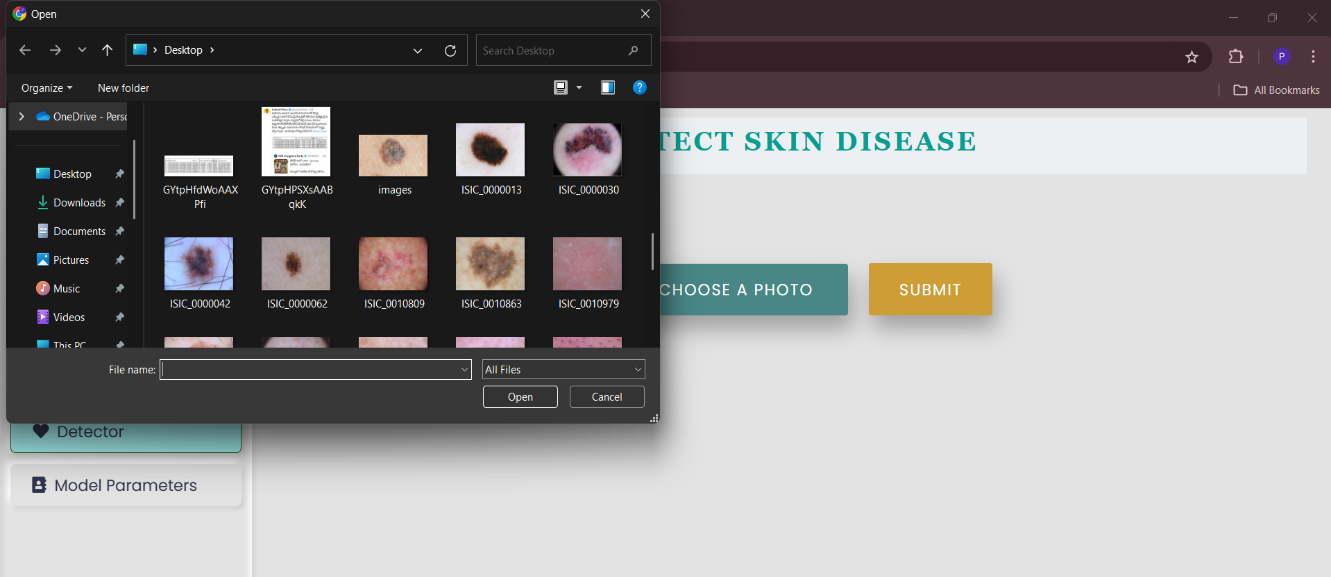 Figure 4 Upload an image
Figure 4 Upload an image
The "Upload an Image" functionality allows users to select and upload a photo of a skin condition for analysis. By clicking the "Choose a Photo" button, a file explorer window opens, enabling the user to browse their local storage and select an image file. This step is the initial phase of the detection process, where the selected image will be processed upon submission to identify and classify the skin condition. The feature is designed for ease of use and supports a variety of image file formats.
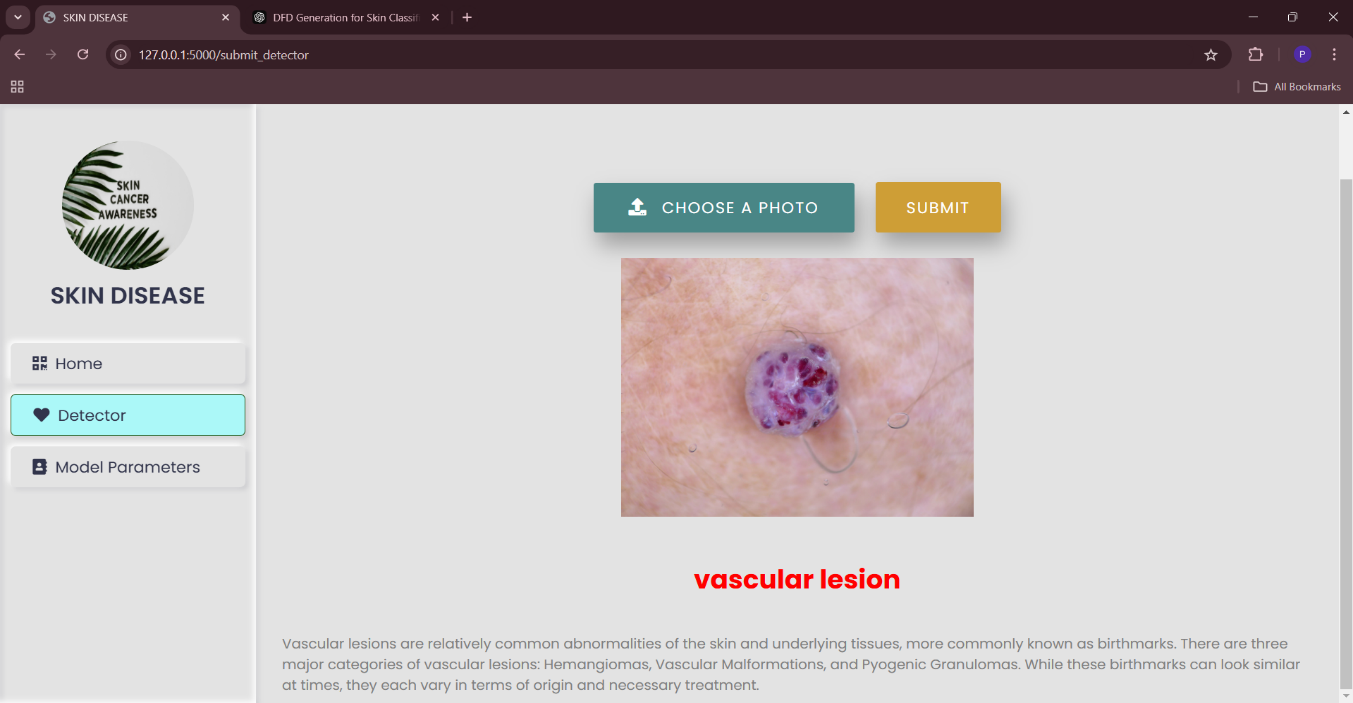 Figure 5 Prediction
Figure 5 Prediction
The "Prediction" functionality processes the uploaded image and identifies the type of skin condition depicted. In this example, the system predicts the condition as a "vascular lesion," displaying the diagnosis prominently along with the corresponding image. Below the result, a brief explanation provides insights into the condition, its types, and other relevant details. This feature ensures users not only receive a diagnosis but also a basic understanding of the predicted condition.
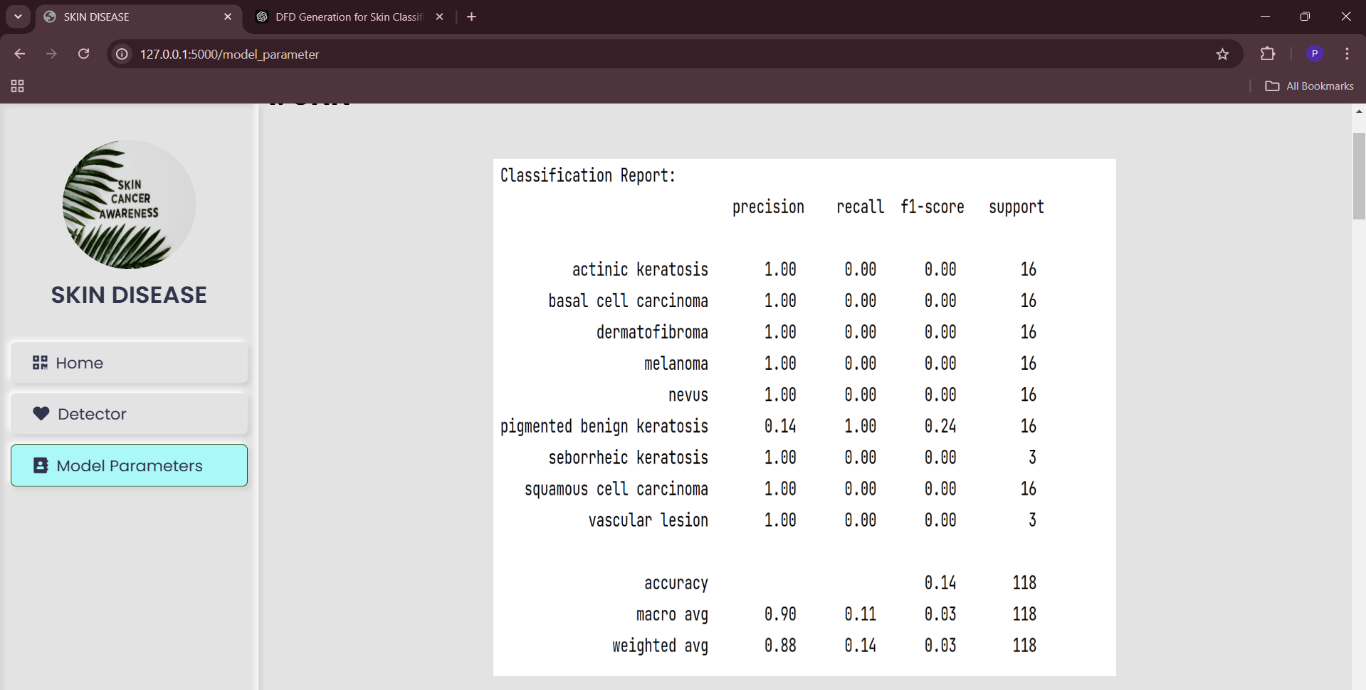 Figure 6 Model Parameters
Figure 6 Model Parameters
The "Model Parameters" section provides a detailed classification report that evaluates the model's performance. The metrics include Precision, Recall, F1-Score, Support. Additionally, metrics like accuracy, macro average, and weighted average are included to summarize the model's performance across all classes. This report helps in understanding the model's strengths and weakness
Conclusion
The ongoing implementation of the skin disease identification and classification system, leveraging deep learning techniques, holds great promise for advancing dermatological diagnostics. The integration of Convolutional Neural Networks (CNNs), ResNet, and EfficientNet showcases the potential for achieving robust and accurate classification of skin lesions. Drawing inspiration from pioneering work, such as that by Esteva et al. (2017), our project aims to attain dermatologist-level accuracy in skin cancer classification. The inclusion of diverse models, including CNNs for generalization, ResNet for handling deep architectures, and EfficientNet for efficient scaling, contributes to the development of a comprehensive skin disease classification system. Looking ahead, ongoing monitoring of model performance, regular updates to incorporate new research findings, and potential collaborations with health- care professionals will be crucial for enhancing the system’s accuracy and relevance. Exploring opportunities to expand the dataset and improve model interpretability remains a focus for future work.
References
[1] Koteswara Rao Kodepogu, Jagadeeswara Rao Annam(2022). Novel deep convolutional neural network. Journal of International Information and Engineering Technology Association (IIETA). [2] Oussama El Gannour, Soufiane Hamida, Yasser Lamalem, Bouchaib Cherradi, Shawki Saleh(2023). Enhancing skin diseases classification. Journal of Science and information(SAI)Organization Limited. [3] Jessica S. Velasco, Jomer V. Catipon, Edmund G. Monilar, Villamor M. Amon, Glenn C. Virrey, Lean Karlo S. Tolentino (2023). Classification of Skin Disease Using Transfer Learning in Convolutional Neural Networks. Journal of International Journal of Emerging Technology and Advanced Engineering. [4] Shivam Pandey, Sanchary Nandy, Shivani Bansal (2023). Skin Disease Detection Based on Deep Learning. Journal of International Journal of Scientific Research in Science, Engineering and Technology. [5] Mingjun Wei, Qiwei Wu, Hongyu Ji, Jingkun Wang, Tao Lyu, Jinyun Liu , and Li Zhao (2023). A Skin Disease Classification Model Based on DenseNet and ConvNeXt Fusion. Journal of Multidisciplinary Digital Publishing Institute journal. [6] Raghav Agarwal and Deepthi Godavarthi (2023). Skin Disease Classification Using CNN Algorithms. Journal of EAI Endorsed Transactions on Pervasive Health and Technology
Copyright
Copyright © 2025 Pathri Mahanthesh, Prajwal G M, Narravula Raaja Chaithanya Vedh, N Rahul. This is an open access article distributed under the Creative Commons Attribution License, which permits unrestricted use, distribution, and reproduction in any medium, provided the original work is properly cited.

Download Paper
Paper Id : IJRASET66205
Publish Date : 2024-12-31
ISSN : 2321-9653
Publisher Name : IJRASET
DOI Link : Click Here
 Submit Paper Online
Submit Paper Online

